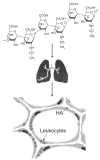The Competitive Interaction of Alveolar Wall Distention with Elastin Crosslinking: A Mechanistic Approach to Emergent Phenomena in Pulmonary Emphysema
- PMID: 40422205
- PMCID: PMC12110103
- DOI: 10.3390/cells14100702
The Competitive Interaction of Alveolar Wall Distention with Elastin Crosslinking: A Mechanistic Approach to Emergent Phenomena in Pulmonary Emphysema
Abstract
Emergent phenomena arise from the interaction of competing forces at multiple scale levels, resulting in complex outcomes that are not readily apparent from analyzing the individual components. Regarding biological systems, when a critical threshold is reached, a phase transition occurs, producing a spontaneous system reorganization characterized by recognizable molecular, microscopic, and macroscopic changes. The current paper explores the emergent phenomena underlying the pathogenesis of pulmonary emphysema, a disease characterized by progressive airspace enlargement. The competitive relationship between mechanical strain imposed on alveolar walls and a countervailing increase in elastin crosslinking to prevent alveolar wall rupture leads to airspace enlargement as the balance between these two processes shifts toward increasing lung injury. This phase transition is also accompanied by an accelerated release of peptide-free elastin-specific desmosine crosslinks as the mean alveolar wall diameter begins to increase, suggesting their potential use as a biomarker for the molecular changes that precede the development of pulmonary emphysema. Early detection of the disease would allow more timely therapeutic intervention involving multiple agents that address the complexities of emergent phenomena at different scale levels.
Keywords: desmosine; elastin; emergent phenomena; hyaluronan; pulmonary emphysema.
Conflict of interest statement
The author declares no conflict of interest.
Figures






References
Publication types
MeSH terms
Substances
LinkOut - more resources
Full Text Sources

